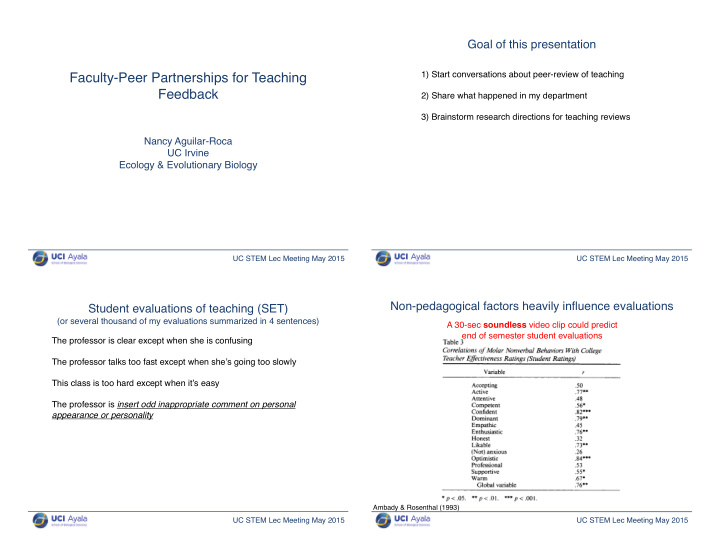



Goal of this presentation 1) Start conversations about peer-review of teaching Faculty-Peer Partnerships for Teaching Feedback 2) Share what happened in my department 3) Brainstorm research directions for teaching reviews Nancy Aguilar-Roca UC Irvine Ecology & Evolutionary Biology UC STEM Lec Meeting May 2015 UC STEM Lec Meeting May 2015 Non-pedagogical factors heavily influence evaluations Student evaluations of teaching (SET) (or several thousand of my evaluations summarized in 4 sentences) A 30-sec soundless video clip could predict end of semester student evaluations The professor is clear except when she is confusing The professor talks too fast except when she’s going too slowly This class is too hard except when it’s easy The professor is insert odd inappropriate comment on personal appearance or personality Ambady & Rosenthal (1993) UC STEM Lec Meeting May 2015 UC STEM Lec Meeting May 2015
Students are biased SETs have statistical issues 1. The course instructor shows enthusiasm for and is interested in the subject. 19 9 (Excellent) Frequency of “genius” in student comments Value: 9 2 8 Value: 8 2 7 Value: 7 1 6 (Good) Categorical data Value: 6 0 5 Value: 5 0 4 Value: 4 0 3 (Fair) Value: 3 0 2 Value: 2 0 1 (Barely Satisfactory) Value: 1 0 0 (Unsatisfactory) Value: 0 0 Not Applicable No Value 8.63 Mean 9.00 Median 0.81 Std Dev 4. The course instructor shows enthusiasm for and is interested in the subject. A A- B+ B B- 192 41 14 5 1 Value: 4 Value: 3.7 Value: 3.3 Value: 3 Value: 2.7 C+ C C- D F NA 0 0 0 0 0 2 Value: 2.3 Value: 2 Value: 1.7 Value: 1 Value: 0 No Value Mean Median Std Dev 3.89 4.00 0.24 Which summary variables are most important? Uses per million words of text http://benschmidt.org/profGender UC STEM Lec Meeting May 2015 UC STEM Lec Meeting May 2015 Is there any value for SETs? Who should evaluate faculty and how? UC Berkeley Department of Statistics (2013) Think - Pair - Share Faculty provide a teaching statement, syllabi, notes, websites, 1) What are the benefits of SETs? Have you ever changed assignments, exams, videos, statements on mentoring, or any other something in your teaching because student comments? relevant materials 2) If you could re-write the SET for your campus, what would At least before every “milestone” review (mid-career, tenure, full, step VI), be the most useful question to include? a faculty member attends at least one of the candidate’s lectures and comments on it, in writing. Distributions of SET scores are reported, along with response rates. Averages of scores are not reported. Note : reviewing one lecture is ~4hr time commitment for reviewer Stark & Freishtat. 2014 UC STEM Lec Meeting May 2015 UC STEM Lec Meeting May 2015
Who should evaluate faculty and how? Evaluation Tools UC Berkeley Department of Statistics (2013) Lesson design and implementation, Propositional Knowledge, Faculty provide a teaching statement, syllabi, notes, websites, Procedural Knowledge, Student-teacher classroom interaction, assignments, exams, videos, statements on mentoring, or any other Student-student classroom interaction relevant materials At least before every “milestone” review (mid-career, tenure, full, step VI), Relies heavily on Likert scales a faculty member attends at least one of the candidate’s lectures and comments on it, in writing. Distributions of SET scores are reported, along with response rates. Averages of scores are not reported. Note : reviewing one lecture is ~4hr time commitment for reviewer http://physicsed.buffalostate.edu/AZTEC/RTOP/RTOP_full/index.htm Stark & Freishtat. 2014 UC STEM Lec Meeting May 2015 UC STEM Lec Meeting May 2015 Evaluation tools Evaluation tools COPUS (Smith et al. 2013) FIRST-IV COPUS 1. Students doing 2. instructor doing 3. Engagement Comments: EG: explain difficult coding choices, flag key points for feedback for the instructor, identify good L Ind CG WG OG AnQ SQ WC Prd SP T/Q W O Lec RtW Fup PQ CQ AnQ MG 1o1 D/V Adm W O L M H min analogies, etc. Components Needs Improvement Progressing Accomplished Well 0 - 2 Engagement of students o o o Interaction limited; students do not ask Students attentive, listening, taking notes most Interaction of instructor with students, between 2 questions of time, but do not appear to be interacting students, and with instructional material o with the material o Big Idea: Do students appear to be Instructor lecture without regard to Students contribute to flow of class meeting; o 4 student participation Students asking questions when prompted, but maintaining students interest engaged? What is instructor doing to o o questions are clarifying, confirmatory or lower Students appear disengaged with Students discussing material entering into higher engage students? level instructor, the material and each other level problem solving and discourse 6 o o o Students are engaged in activities but do not Engagement not aligned with learning Students appear to see relevance of what they are Observation codes understand why or how they relate to learning goals doing goals o Instructor asks direct questions and speaks directly o Students working in groups, but seem off task 1. Students are Doing to students to actively engage in dialog or involved in unproductive discussion L Listening to instructor/taking n Ind Individual thinking/problem solv question or another question/p CG Discuss clicker question in grou WG Working in groups on workshee OG Other assigned group activity, s AnQ Student answering a question p SQ Student asks question WC Engaged in whole class discussio by instructor Prd Making a prediction about the SP Presentation by student(s) TQ Test or quiz W Waiting (instructor late, workin O Other – explain in comments UC STEM Lec Meeting May 2015 UC STEM Lec Meeting May 2015 � �
Recommend
More recommend